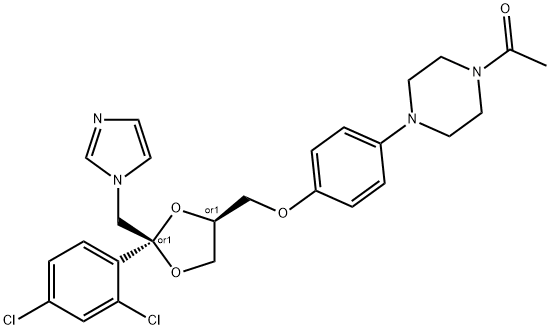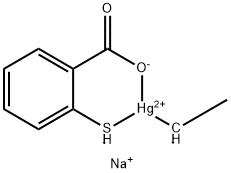PHENYLMERCURY NITRATE
- CAS NO.:55-68-5
- Empirical Formula: C6H5HgNO3
- Molecular Weight: 339.7
- MDL number: MFCD00137341
- EINECS: 200-242-9
- SAFETY DATA SHEET (SDS)
- Update Date: 2024-12-18 14:08:52

What is PHENYLMERCURY NITRATE?
Chemical properties
white crystalline powder
Chemical properties
Phenylmercuric nitrate PhEur 6.0, and USP32-NF27, is an equimolecular compound of phenylmercuric hydroxide and phenylmercuric nitrate; it occurs as a white, crystalline powder with a slight aromatic odor.
The Uses of PHENYLMERCURY NITRATE
Pharmaceutic aid (antimicrobial agent).
Production Methods
Phenylmercuric nitrate is readily formed by heating benzene with mercuric acetate, and treating the resulting acetate with an alkali nitrate.
Definition
ChEBI: Phenylmercuric nitrate is a member of benzenes.
brand name
Phenmerzyl Nitrate (Marion Merrell Dow).
General Description
Lustrous scales decomposing at 187-190°C. Very slightly soluble in water. Used as an antiseptic, germicide, fungicide.
Air & Water Reactions
Very slightly soluble in water.
Reactivity Profile
Strongly reactive with many other groups. Incompatible with acids and bases. Organometallics are good reducing agents and therefore incompatible with oxidizing agents. Often reactive with water to generate toxic or flammable gases. Generally highly toxic. Often react on contact with tissues to give toxic products.
Health Hazard
Highly toxic, may be fatal if inhaled, swallowed or absorbed through skin. Avoid any skin contact. Effects of contact or inhalation may be delayed. Fire may produce irritating, corrosive and/or toxic gases. Runoff from fire control or dilution water may be corrosive and/or toxic and cause pollution.
Fire Hazard
Non-combustible, substance itself does not burn but may decompose upon heating to produce corrosive and/or toxic fumes. Containers may explode when heated. Runoff may pollute waterways.
Pharmaceutical Applications
Phenylmercuric salts are used as antimicrobial preservatives mainly
in ophthalmic preparations, but are also used in cosmetics, parenteral, and topical pharmaceutical formulations;
Phenylmercuric salts are active over a wide pH range against
bacteria and fungi and are usually used in neutral to alkaline
solutions, although they have also been used effectively at slightly
acid pH. In acidic formulations, phenylmercuric
nitrate may be preferred to phenylmercuric acetate or phenylmercuric
borate as it does not precipitate.
Phenylmercuric nitrate is also an effective spermicide, although
its use in vaginal contraceptives is no longer recommended;
A number of adverse reactions to phenylmercuric salts have been
reported, and concern at the toxicity of mercury compounds may preclude the use of phenylmercuric salts under certain circumstances;
Safety Profile
Poison by intravenous route. FDA over-the-counter drug. When heated to decomposition it emits very toxic fumes of Hg and NOx. See also MERCURY COMPOUNDS and NITRATES.
Safety
Phenylmercuric nitrate and other phenylmercuric salts have been
widely used as antimicrobial preservatives in parenteral and topical
pharmaceutical formulations. However, concern over the use of
phenylmercuric salts in pharmaceuticals has increased as a result of
greater awareness of the toxicity of mercury and other mercury
compounds. This concern must, however, be balanced by the
effectiveness of these materials as antimicrobial preservatives and
the low concentrations in which they are employed.
Phenylmercuric salts are irritant to the skin at 0.1% w/w
concentration in petrolatum.In solution, they may give rise to
erythema and blistering 6–12 hours after administration. In a
modified repeated insult patch test, a 2% w/v solution was found to
produce extreme sensitization of the skin.
Eye drops containing phenylmercuric nitrate as a preservative
should not be used continuously for prolonged periods as
mercurialentis, a brown pigmentation of the anterior capsule of
the lens may occur. Incidence is 6% in patients using eye drops for
greater than 6 years; however, the condition is not associated with
visual impairment.Cases of atypical band keratopathy have
also been attributed to phenylmercuric nitrate preservative in eye
drops.
Concern that the absorption of mercury from the vagina may be
harmful has led to the recommendation that phenylmercuric nitrate
should not be used in intravaginal formulations.
(mouse, IV): 27 mg/kg
(mouse, oral): 50 mg/kg
(rat, SC): 63 mg/kg
Storage
All phenylmercuric compound solutions form a black residue of
metallic mercury when exposed to light or after prolonged storage.
Solutions may be sterilized by autoclaving, although significant
amounts of phenylmercuric salts may be lost, hence reducing
preservative efficacy, owing to incompatibilities with packaging
components or other excipients, e.g. sodium metabisulfite.
Phenylmercuric nitrate should be stored in a well-closed
container, protected from light, in a cool, dry place.
Incompatibilities
The antimicrobial activity of phenylmercuric salts may be reduced
in the presence of anionic emulsifying agents and suspending agents,
tragacanth, starch, talc, sodium metabisulfite,sodium thiosulfate,disodium edetate,and silicates (bentonite, aluminum
magnesium silicate, magnesium trisilicate, and kaolin).
Phenylmercuric salts are incompatible with halides, particularly
bromides and iodides, as they form less-soluble halogen compounds.
At concentrations of 0.002% w/v precipitation may not
occur in the presence of chlorides. Phenylmercuric salts are also
incompatible with aluminum and other metals, ammonia and
ammonium salts, amino acids, and with some sulfur compounds,
e.g. in rubber.
Phenylmercuric salts are absorbed by rubber stoppers and some
types of plastic packaging components; uptake is usually greatest to
natural rubbers and polyethylene, and least to polypropylene.
Incompatibilities with some types of filter membranes may also
result in loss of phenylmercuric salts following sterilization by
filtration.
Regulatory Status
Included in the FDA Inactive Ingredients Database (parenteral and
ophthalmic preparations). Included in parenteral products and eye
drops in the EU. Included in the Canadian List of Acceptable Nonmedicinal
Ingredients (ophthalmic, nasal and otic preparations only
up to 0.002%; there must be no other suitable alternative
preservative).
Prohibited in first aid antiseptic drug products, antimicrobial
diaper rash drug products and vaginal contraceptive drug products
in the USA. Limited uses permitted in Japan and the EU for
cosmetics.
Properties of PHENYLMERCURY NITRATE
| Melting point: | 188-190℃ (decomposition) |
| solubility | Very slightly soluble in water and in ethanol (96 per cent), slightly soluble in hot water. It dissolves in glycerol and in fatty oils. |
| form | solid |
| Stability: | Stable. |
| EPA Substance Registry System | Phenylmercuric nitrate (55-68-5) |
Safety information for PHENYLMERCURY NITRATE
Computed Descriptors for PHENYLMERCURY NITRATE
PHENYLMERCURY NITRATE manufacturer
Belami Fine Chemicals Private Limited
Innovative
New Products
4,4-Difluoropiperidine hydrochloride tert-butyl 9-methoxy-3-azaspiro[5.5]undecane-3-carboxylate Indole Methyl Resin N-Isopropylurea N,N-Dicyclohexylcarbodiimide(DCC) MELDRUMS ACID 5-METHYLISOXAZOLE-4-CARBOXYLIC ACID Magnessium Bis glycinate Zinc ascorbate 1-bromo-2-butyne 2-acetamidophenol 9(10H)-anthracenone Erythrosin B, 4-Piperidinopiperidine 2-((4-morpholinophenylamino) (methylthio) methylene) malononitrile 2,4-dihydroxybenzaldehyde 3-(4-morpholinophenylamino)-5-amino-1H-pyrazole-4-carbonitrile Methyl 2-methylquinoline-6-carboxylate 2,6-dichloro-4-nitropyridine 4-Bromo-2-chlorobenzonitrile 2-(benzylamino)acetic acid hydrochloride 4-(tert-Butoxycarbonylamino)but- 2-ynoic acid 3,4-dihydro-2H-benzo[b][1,4]dioxepine 1-Phenyl-1-cycloprppanecarboxylicacidRelated products of tetrahydrofuran








You may like
-
 55-68-5 Phenylmercuric nitrate 98%View Details
55-68-5 Phenylmercuric nitrate 98%View Details
55-68-5 -
 Phenyl Mercuric Nitrate (Phenylmercuric Nitrate) CAS: 55-68-5View Details
Phenyl Mercuric Nitrate (Phenylmercuric Nitrate) CAS: 55-68-5View Details
55-68-5 -
 Phenylmercuric Nitrate (CAS Number: 8003-05-2), 1 kg / 5 kg / 10 kg / 25 kgView Details
Phenylmercuric Nitrate (CAS Number: 8003-05-2), 1 kg / 5 kg / 10 kg / 25 kgView Details
8003-05-2 -
 Phenyl Mercuric Nitrate, Purity: 99%View Details
Phenyl Mercuric Nitrate, Purity: 99%View Details
10045-94-0 -
 3-(4-amino-1-oxoisoindolin-2-yl)-1-methylpiperidine-2,6-dione 98%View Details
3-(4-amino-1-oxoisoindolin-2-yl)-1-methylpiperidine-2,6-dione 98%View Details -
 20677-73-0 (2,2-diethoxyethyl)methylamine 98%View Details
20677-73-0 (2,2-diethoxyethyl)methylamine 98%View Details
20677-73-0 -
 3-(4-(hydroxyamino)-1-oxoisoindolin-2-yl)piperidine-2,6-dione 98%View Details
3-(4-(hydroxyamino)-1-oxoisoindolin-2-yl)piperidine-2,6-dione 98%View Details -
 57381-49-4 2-bromo-4-chlorobenzonitrile 98%View Details
57381-49-4 2-bromo-4-chlorobenzonitrile 98%View Details
57381-49-4
